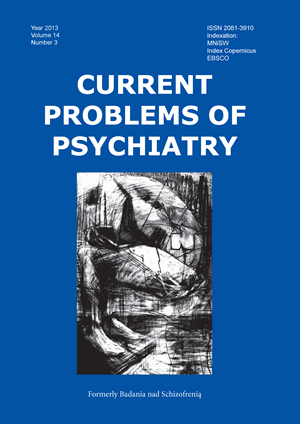Psychological functioning of drivers who present risky driving behavior and drive under influence of alcohol
Keywords:
driving under the influence, adolescence, alcohol addiction, personality, Jessors’ problem behavior theoryAbstract
The purpose of this article is to depict psychological functioning of people who present risky and drunken driving. Police statistics indicate two specific groups of drivers causing accidents. The first group is composed of adolescents whose way of functioning is explained further from the perspective of Jessors’ problem behavior theory. The second group comprises individuals repeatedly sentenced for driving while intoxicated. Many studies on these groups involved multiple factor analysis undertaken in order to determine correlation between social, behavioral, and psychological factors.
References
1. Bąk J., Bąk-Gajda D. Psychologiczne czynniki bezpieczeństwa ruchu drogowego. Eksploatacja i Niezawodność., 2008; 3: 22-29.
2. Harwas-Napierała B., Trempała J. Psychologia rozwoju człowieka. Tom 2. Charakterystyka okresów życia człowieka. Warszawa: Wydawnictwo Naukowe PWN: 2000.
3. Morylowska, Makara-Studzińska M. Rodzina z zachowania ryzykowne młodzieży. Roczniki Teologiczne., 2007; 10: s. 59-69.
4. Gaś Z. B. Ankiety EPIDAL jako narzędzia kompleksowej samooceny u czniów w zakresie zachowań dysfunkcjonalnych i konwencjonalnych. W: Gaś Z. B. red., Badanie zapotrzebowania na profilaktykę w szkole. Lublin: Pracownia Wydawnicza Fundacji „Masz Szansę”; 2004, s.175-184.
5. Gaś Z. B. Teoria zachowań dewiacyjnych według S. R. Jessorów. W: Gaś Z. B. red., Psychologia wychowawcza stosowana. Wybrane zagadnienia. Lublin: Wydawnictwo UMCS; 1995; s. 91-96.
6. Huflejt-Łukasik M. Ja i procesy samoregulacji. Różnice między zdrowiem a zaburzeniami psychicznymi. Warszawa: Wydawnictwo Naukowe „Scholar”: 2010.
7. Kubacka-Jasiecka D. Agresja i autodestrukcja z perspektywy obronno-adaptacyjnych dążeń Ja. Kraków: Wydawnictwo Uniwersytetu Jagiellońskiego: 2006.
8. Szczukiewicz P. Nałogowa osobowość. Świat Problemów., 2004; 3: 1-4.
9. Jonah, B.A. Sensation seeking and risky driving: a review and synthesis of the literature. Accid. Anal. Prev., 1997; 29; 5: 651-665.
10. Johnson V., Raskin White H. An investigation of factors related to intoxicated driving behaviours among youth. Journal of Studies on Alcohol., 1989; 50: 320-330.
11. Holt L. J., O’Malley S. S., Rounsaville B. J., Ball S. A. Depressive Symptoms, Drinking Consequences, and Motivation to Change in First Time DWI Offenders. Am J. Drug Alcohol Abuse., 2009; 35: 117-122.
12. Karlsson G., Romelsjo A. A longitudinal study of social, psychological and behavioural factors associated with drunken driving and public drunkenness. Addiction., 1997; 92:4: 447-457.
13. Oltendal S., Rundmo T. The effects of personality and gender on risky driving behaviour and accident involvement. Safety Science., 2006; 44: 621-628.
14. Chliaoutakis J. E., Demakakos P., Tzamalouka G., Bakou V., Koumaki M., Darviri C. Aggressive behavior while driving as predictor of self-reported car crashes. J Safety Research., 2002; 33:4: 431-443.
15. Gulliver P., Begg D. Influences during adolescence on perceptions and behaviour related to alkohol use and unsafe driving as young adults. Accid. Anal. Prev., 2004; 36: 773-781.
16. Bina M., Graziano F., Bonino S. Risky driving and life-styles in adolescence. Accid. Anal. Prev., 2006; 38: 472-481.
17. Hatakka M., Keskinen E., Gregersen N. P., Glad A., Hernetkoski K. From control of the vehicle to personal self-control; broadening the perspectives to driver education. Accid. Anal. Prev., Transport. Res. Part F 5., 2002; 201-215.
18. Ulleberg P. Personality subtypes of young drivers. Relationship to risk-taking preferences, accident involvement, and response to a traffic safety campaign. Transportation Research Part F 4., 2002: 279-297.
19. Vassallo S., Smart D., Sanson A., Harrison W., Harris A., Cockfiels S., McIntyre A. Risky driving among young Australian drivers: Trends, precursors and correlates., Accid. Anal. Prev., 2007; 39: 444-458.
20. Beirness, D.J., Simpson, H.M., 1988. Lifestyle correlates of risky driving and accident involvement among youth. Alcohol Drugs Driving 4, 193–204.
21. Bingham, C.R., Shope, J.T. Adolescent problem behavior and problem driving in young adulthood. J. Adolesc. Res., 2004; 19: 205–223.
22. Caspi, A., Begg, D., Dickson, N., Harrington, H., Langley, J., Moffitt, T.E., Silva, P.A. Personality differences predict health risk behaviors in young adulthood: evidence from a longitudinal study. J. Personal. Social Psychol., 1997; 73: 1052–1063.
23. Beirness, D.J. Do we really drive as we live? The role of personality factors in road crashes. Alcohol Drugs Driving., 1993; 9: 129–143.
24. Machin M. A., Sankey K. Relationships between young drivers’ personality characteristics, risk perceptions, and driving behavior. Accid. Anal. Prev., 2008; 40: 541-547.
25. McKenna F. P., Horswill M. S. Risk taking from the participants perspective: the case of driving and accident risk. Health Psychol., 2006; 25: 163-170.
26. Ulleberg P., Rundmo T. Personality, attitudes and risk perceptron as predictors of risky driving behaviour among young drivers. Safety Science., 2003; 41: 427-443.
27. Rundmo, T. Perceived risk, health behaviour and consumer behaviour. Journal of Risk Research 2., 1999: 187–200.
28. Horvath, P., Zuckerman, M., 1993. Sensation-seeking, risk appraisal and risk behaviour. Personality and Individual Differences., 1993; 14: 41–52.
29. Zakrajesk S. J., Shope J. T., Longituidinal examination of underage drinking and subsequent drinking and risky driving. J. Safety Res., 2006; 37: 443-451.
30. Hubicka B., Kallmen H., Hiltunen A., Bergman H. Personality traits and mental health of severe drunk drivers in Sweden. Soc. Psychiat. Epidemiol., 2010; 45: 723-731.
31. Hauser J., Rybakowski J. Three clusters of male alcoholics. Drug Alcohol. Depend., 1997; 48: 243-250.
32. Nochajski T. H., Stasiewicz P. R. Relapse to driving under the influence (DUI): A review. Clin. Psych. Rev., 2006; 26: 179-195.


